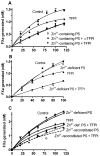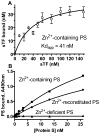Zn²(+) -containing protein S inhibits extrinsic factor X-activating complex independently of tissue factor pathway inhibitor
- PMID: 20492471
- PMCID: PMC2955986
- DOI: 10.1111/j.1538-7836.2010.03919.x
Zn²(+) -containing protein S inhibits extrinsic factor X-activating complex independently of tissue factor pathway inhibitor
Abstract
Background: Protein S (PS) has direct anticoagulant activity, independently of activated protein C (APC). The mechanisms underlying this activity remain unclear, because PS preparations differ in activity, giving rise to conflicting results. Some purification procedures result in loss of intramolecular Zn²(+) , which is essential for inhibition of prothrombinase.
Objective: To investigate the inhibition of extrinsic factor (F)Xase by Zn²(+) -containing PS.
Methods: Purified component extrinsic FXase assays were used to determine FXa generation in the presence and absence of PS and/or tissue factor pathway inhibitor (TFPI). Binding assays, immunoblots and thrombin generation assays in plasma supported the FXase data.
Results: Zn²(+) -containing PS potently inhibited extrinsic FXase in the presence of saturating phospholipids, independently of TFPI, whereas inhibition of extrinsic FXase by Zn²(+) -deficient PS required TFPI. Immunoblots for FXa and functional assays showed that Zn²(+) -containing PS inhibited primarily the quantity of FXa formed by tissue factor (TF)-FVIIa, rather than FXa amidolytic activity. Zn²(+) -containing PS, but not Zn²(+) -deficient PS, bound to TF with high affinity (K(dapp) = 41 nm) and targeted TF function. Binding of PS to FVIIa was negligible, whereas PS showed appreciable binding to FX. Increasing FX concentrations 10-fold reduced PS inhibition five-fold, suggesting that PS inhibition of FXase is FX-dependent. PS also exhibited TFPI-independent and APC-independent anticoagulant activity during TF-initiated thrombin generation in plasma.
Conclusions: PS that retains native Zn²(+) also retains anticoagulant functions independently of APC and TFPI. Inhibition of extrinsic FXase by PS at saturating levels of phospholipids depends on PS retention of intramolecular Zn²(+) , interaction with FX, and, particularly, interaction with TF.
© 2010 International Society on Thrombosis and Haemostasis.
Conflict of interest statement
The authors state that they have no conflict of interest.
Figures









Similar articles
-
Platelet protein S directly inhibits procoagulant activity on platelets and microparticles.Thromb Haemost. 2013 Feb;109(2):229-37. doi: 10.1160/TH12-08-0622. Epub 2012 Dec 13. Thromb Haemost. 2013. PMID: 23238804 Free PMC article.
-
Inhibition of tissue factor:factor VIIa-catalyzed factor IX and factor X activation by TFPI and TFPI constructs.J Thromb Haemost. 2014 Nov;12(11):1826-37. doi: 10.1111/jth.12713. Epub 2014 Oct 12. J Thromb Haemost. 2014. PMID: 25163770
-
Plasma protein S contains zinc essential for efficient activated protein C-independent anticoagulant activity and binding to factor Xa, but not for efficient binding to tissue factor pathway inhibitor.FASEB J. 2009 Jul;23(7):2244-53. doi: 10.1096/fj.08-123174. Epub 2009 Feb 24. FASEB J. 2009. PMID: 19244162 Free PMC article.
-
Protein S is a cofactor for tissue factor pathway inhibitor.Thromb Res. 2008;122 Suppl 1:S60-3. doi: 10.1016/S0049-3848(08)70021-5. Thromb Res. 2008. PMID: 18691502 Review.
-
TFPI-dependent activities of protein S.Thromb Res. 2012 May;129 Suppl 2:S23-6. doi: 10.1016/j.thromres.2012.02.024. Epub 2012 Mar 15. Thromb Res. 2012. PMID: 22425215 Review.
Cited by
-
Phosphorylation of protein S by platelet kinases enhances its activated protein C cofactor activity.FASEB J. 2013 Jul;27(7):2918-25. doi: 10.1096/fj.12-225961. Epub 2013 Apr 11. FASEB J. 2013. PMID: 23580615 Free PMC article.
-
Coagulation factor V mediates inhibition of tissue factor signaling by activated protein C in mice.Blood. 2015 Nov 19;126(21):2415-23. doi: 10.1182/blood-2015-05-644401. Epub 2015 Sep 4. Blood. 2015. PMID: 26341257 Free PMC article.
-
Platelet protein S directly inhibits procoagulant activity on platelets and microparticles.Thromb Haemost. 2013 Feb;109(2):229-37. doi: 10.1160/TH12-08-0622. Epub 2012 Dec 13. Thromb Haemost. 2013. PMID: 23238804 Free PMC article.
-
Relationship between serum zinc level and sepsis-induced coagulopathy.Int J Hematol. 2022 Jan;115(1):87-95. doi: 10.1007/s12185-021-03225-4. Epub 2021 Oct 20. Int J Hematol. 2022. PMID: 34669153
-
Protein C anticoagulant and cytoprotective pathways.Int J Hematol. 2012 Apr;95(4):333-45. doi: 10.1007/s12185-012-1059-0. Epub 2012 Apr 5. Int J Hematol. 2012. PMID: 22477541 Free PMC article. Review.
References
-
- Dahlback B. The tale of protein S and C4b-binding protein, a story of affection. Thromb Haemost. 2007;98:90–6. - PubMed
-
- Schwarz HP, Fischer M, Hopmeier P, Batard MA, Griffin JH. Plasma protein S deficiency in familial thrombotic disease. Blood. 1984;64:1297–300. - PubMed
-
- Mahasandana C, Suvatte V, Marlar RA, Manco-Johnson MJ, Jacobson LJ, Hathaway WE. Neonatal purpura fulminans associated with homozygous protein S deficiency (Letter) Lancet. 1990;335:61–2. - PubMed
-
- Walker FJ, Chavin SI, Fay PJ. Inactivation of factor VIII by activated protein C and protein S. Arch Biochem Biophys. 1987;252:322–8. - PubMed
Publication types
MeSH terms
Substances
Grants and funding
LinkOut - more resources
Full Text Sources
Miscellaneous

